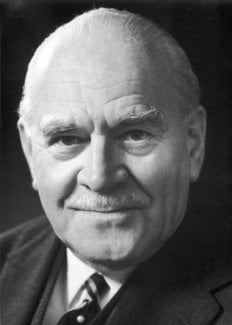Ronald G.W. Norrish
Biographical

Ronald George Wreyford Norrish was born in Cambridge on November 9th, 1897. His father, a native of Crediton, Devonshire, came to Cambridge as a young Pharmacist to open one of the early shops of Boots, the Chemists, and remained there for the rest of his long life.
After spending his early years at the local Board school, Norrish obtained a scholarship to the Perse Grammar School in 1910. He remembers with deep gratitude his early teachers, in particular Rouse, Turnbull and Hersch, who gave dedicated and individual help to promising young scholars. In 1915 he obtained an entrance scholarship to Emmanuel College, Cambridge in Natural Sciences, but left in 1916 with a commission in the Royal Field Artillery for service in France. He was made prisoner of war in March 1918 and spent the rest of the war in Germany, first at Rastatt and later at Graudenz in Poland. Repatriated in 1919, he returned to Emmanuel College where he has remained ever since, first as a student and after 1925 as a Fellow. Norrish’s early research was inspired by Eric Redeal (now Sir Eric Redeal) under whose lively supervision he first took up the study of Photochemistry.
In 1925 he was made Demonstrator and in 1930, Humphrey Owen Jones Lecturer in Physical Chemistry in the Department of Chemistry at Cambridge and upon the death of the first Professor of Physical Chemistry, Dr. T.M. Lowry, was appointed to the Professorship in 1937. He occupied the chair until 1965 when he retired as Emeritus Professor of Physical Chemistry in the University.
Norrish has had the good fortune to work with many gifted students and with them has carried out a wide range of research in the fields of Photochemistry and Reaction Kinetics, including Combustion and Polymerisation. As the study of Chemical Kinetics developed, there was a fortunate integration in the various aspects of the study in which his school of work was engaged, as a result of which the importance of Photochemistry and Spectroscopy to Chemical Kinetics in general emerged. All this was sadly brought to a temporary halt in 1940. During the second world war, while still continuing to direct the Department of Physical Chemistry and to teach, Norrish was concerned with a good deal of research work in connection with various ministries and was able to collaborate with his colleagues on various government committees. It was after the war in 1945 when research was recommenced that work was started with the object of observing short lived transients in chemical reactions. In collaboration with his student, now Professor George Porter, this led to the development of Flash Photolysis and Kinetic Spectroscopy which has had considerable influence on the subsequent development of Photochemistry and Reaction Kinetics, and in the hands of workers in many parts of the world is continuing to develop as a powerful technique for the study of all aspects of chemical reaction.
In 1926 Ronald Norrish married Annie Smith who was Lecturer in the Faculty of Education in the University of Wales in Cardiff. They have two daughters and four grandchildren. Much of their time has been spent in travel.
Norrish has served on the Councils of the Chemical Society, the Faraday Society of which he became President in 1951-1955 and on the Council of the Royal Institute of Chemistry of which he was Vice President from 1957 to 1959. He delivered the Liversidge Lecture to the Chemical Society in 1958, the Faraday Memorial Lecture to the Chemical Society in 1965, and the Bakerian Lecture to the Royal Society in 1966. He was President of the British Association Section B (Chemistry) in 1961, and in the same year was made Liveryman of the Worshipful Company of Gunmakers. In 1958 he received the honorary degree of D. de l’U. at the Sorbonne in Paris and also honorary degrees D. Sc. in Leeds and Sheffield in 1965, Liverpool and Lancaster (1968) and British Columbia (1969). He is an honorary member of the Polish Chemical Society and Membre d’honneur of the Société de Chimie Physique in Paris. He is a foreign member of the Polish and the Bulgarian Academies of Sciences, a corresponding member of the Academy of Sciences in Göttingen and of the Royal Society of Sciences in Liege. He is a honorary member of the Royal Society of Sciences in Uppsala and the New York Academy of Sciences. He has received the Meldola medal of the Royal Institute of Chemistry (1926), the Davy medal of the Royal Society (1958), the Lewis medal of the Combustion Institute (1964), the Faraday medal of the Chemical Society (1965) and their Longstaff medal (1969). He was elected Fellow of the Royal Society in 1936 and is still endeavouring to continue to prosecute his scientific activities in Cambridge.
To mark his retirement in 1965, many of his old friends and younger colleagues now occupying distinguished positions in academic and industrial work in Great Britain and abroad collaborated to publish a work entitled “Photochcmistry and Reaction Kinetics”. To them and to all others with whom he has worked for over 50 years he is deeply grateful.
This autobiography/biography was written at the time of the award and later published in the book series Les Prix Nobel/ Nobel Lectures/The Nobel Prizes. The information is sometimes updated with an addendum submitted by the Laureate.
Ronald G.W. Norrish died on June 7, 1978.
Nobel Prizes and laureates
Six prizes were awarded for achievements that have conferred the greatest benefit to humankind. The 12 laureates' work and discoveries range from proteins' structures and machine learning to fighting for a world free of nuclear weapons.
See them all presented here.
